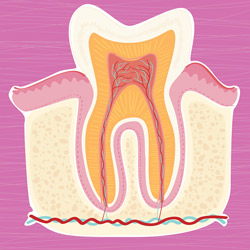Services
Root canal (endodontics)

Root canal (endodontics)
Dentists today believe that the best teeth are our own teeth. They will do everything they can to make sure you keep your teeth. A successful root canal treatment lets you keep your tooth. The only other option is to have it removed. Keeping your tooth helps to prevent your other teeth from going out of alignment and causing jaw problems or gum disease. And saving a tooth avoids having to replace it with a bridge or an implant.
To stop the disease from progressing, antiseptic treatments and special brushing will be required at home for the treatment to be a success (an antibiotic may be prescribed as well).

What is a root canal treatment?
Teeth are made up of three hard layers:
- enamel
- dentin
- cementum
There is a space inside the hard layers of each tooth. It is called the root canal system and it is filled with soft dental pulp made up of nerves and blood vessels that help the tooth grow and develop. Once a tooth is fully grown, it can survive without the pulp. If the pulp of a tooth becomes infected, a root canal (or endodontic treatment) is needed. This treatment involves removing the pulp.
When is a root canal treatment needed?
The pulp may be damaged by cracks in the enamel, a deep cavity or an accident. Bacteria can get into the tooth and infect the pulp, which may cause infection or inflammation. Sometimes the pulp becomes infected and dies without causing any pain.
Your dentist may notice some changes:
-
In the colour of your tooth
-
In the appearance of your gums
-
In the bone or root of the tooth, which show up in an x-ray
If the tooth is in very bad condition, your dentist may decide after an exam and x-rays that the pulp will probably not survive.
In all cases, a root canal can ease or prevent symptoms and save the tooth.
The procedure
-
A member of the dental team places a dental dam around the tooth to protect it during the treatment from the bacteria in your saliva.
-
The dentist or endodontist may give you a local anesthetic (freezing), if there is a risk of pain.
-
The dentist makes a small opening in the tooth to reach the root canal system and the damaged pulp
-
The dentist will take out the pulp by cleaning and enlarging the canal with very fine instruments.
-
The dentist will then fill and seal the canal with a rubber-like material called gutta-percha. He or she will use an obturator, which pre-regulates the instrument temperature to melt the rubber and make a better seal.
-
Lastly, the dentist will seal the opening of the tooth with either a temporary or permanent filling.
Things to consider
A root canal treatment may be completed in one appointment, or it may take several visits, depending on the complexity of the root canal system and on the degree of pulp damage.
Sometimes, if the infection has spread from the tooth to the bone (or abscess), the infection may have to be drained before the root can be filled.
Your tooth may remain tender for one to two weeks after the treatment. Intense pain and swelling are uncommon. If you do experience them, call your dentist or endodontist as soon as possible.
After a root canal, your tooth has to be restored with a filling or a crown in order to look and work as much like a natural tooth as possible. The type of restoration depends on how strong the remaining tooth is. A back tooth will likely need a crown because chewing puts a lot of pressure on back teeth. If not enough of the natural tooth is left, your dentist may use a post to help keep the crown in place. A discoloured tooth can either be bleached, crowned or covered with a veneer.
Re-treatment and root canal surgery
Although a root canal treatment is successful in most cases, a second root canal (re-treatment) may be required. The filling material is taken out and the canal is cleaned again, reshaped and refilled.
A dentist or endodontist may perform root canal surgery when a regular root canal cannot be done or when it has not worked. Surgery is done to:
-
Check the end of the canal for cracks (or fractures);
-
Remove parts of the root that could not be cleaned during the regular treatment;
-
Clear up an infection that did not heal after regular treatment.
All dentists learn how to do root canal treatments in dental school. However, in some complex cases, they may refer you to an endodontist for treatment or surgery.
Most of the time, a tooth that has a root canal by a dentist or an endodontist can be saved, but there are cases where all efforts to save a tooth fail and the tooth must be pulled.
Telephone: (613) 632-4159
Clinique Dentaire Floss
Plaza Hawkesbury
460 county Road 17
Hawkesbury, Ontario
K6A 2R2
Business hours
|
Monday
|
8:00 à 18:00 |
|
Tuesday
|
8:00 à 18:00 |
|
Wednesday
|
9:00 à 18:00 |
|
Thursday
|
8:00 à 18:00 |
|
Friday
|
8:00 à 16:00 |
